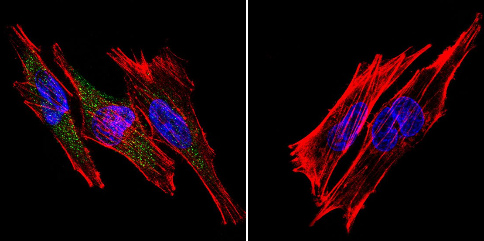
Immunocytochemistry/Immunofluorescence analysis of SERCA1 ATPase shows staining in A2058 cells. SERCA1 ATPase staining (green), F-Actin staining with Phalloidin (red) and nuclei with DAPI (blue) is shown. Cells were grown on chamber slides and fixed with formaldehyde prior to staining. Cells were incubated without (control) or with or ab2819 (1:20) overnight at 4°C, washed with PBS and incubated with a DyLight-488 conjugated goat anti-mouse IgG secondary antibody. Images were taken at 60X magnification.
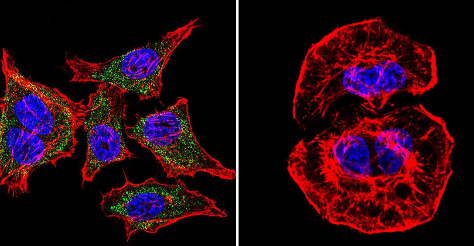
Immunocytochemistry/Immunofluorescence analysis of SERCA1 ATPase shows staining in HeLa cells. SERCA1 ATPase staining (green), F-Actin staining with Phalloidin (red) and nuclei with DAPI (blue) is shown. Cells were grown on chamber slides and fixed with formaldehyde prior to staining. Cells were incubated without (control) or with or ab2819 (1:20) overnight at 4°C, washed with PBS and incubated with a DyLight-488 conjugated goat anti-mouse IgG secondary antibody. Images were taken at 60X magnification.
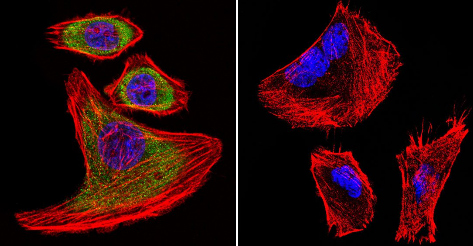
Immunocytochemistry/Immunofluorescence analysis of SERCA1 ATPase shows staining in U251 cells. SERCA1 ATPase staining (green), F-Actin staining with Phalloidin (red) and nuclei with DAPI (blue) is shown. Cells were grown on chamber slides and fixed with formaldehyde prior to staining. Cells were incubated without (control) or with or ab2819 (1:20) overnight at 4°C, washed with PBS and incubated with a DyLight-488 conjugated goat anti-mouse IgG secondary antibody. Images were taken at 60X magnification.
![Anti-SERCA1 ATPase antibody [VE121G9] (ab2819) at 1/500 dilution + Skeletal Muscle (Mouse) Tissue Lysate at 10 µgSecondaryGoat Anti-Mouse IgG H&L (HRP) preadsorbed (ab97040) at 1/5000 dilutiondeveloped using the ECL techniquePerformed under reducing conditions.](http://www.bioprodhub.com/system/product_images/ab_products/2/sub_4/28459_SERCA1-ATPase-Primary-antibodies-ab2819-9.jpg)
Anti-SERCA1 ATPase antibody [VE121G9] (ab2819) at 1/500 dilution + Skeletal Muscle (Mouse) Tissue Lysate at 10 µgSecondaryGoat Anti-Mouse IgG H&L (HRP) preadsorbed (ab97040) at 1/5000 dilutiondeveloped using the ECL techniquePerformed under reducing conditions.
![Anti-SERCA1 ATPase antibody [VE121G9] (ab2819) at 1/1000 dilution (in PBS tweeb 0.05% for 1 hour at 22°C) + Whole tissue lysate of human neck muscle. at 20 µgSecondaryAn HRP-conjugated sheep anti-mouse polyclonal at 1/4000 dilutiondeveloped using the ECL technique](http://www.bioprodhub.com/system/product_images/ab_products/2/sub_4/28460_SERCA1-ATPase-Primary-antibodies-ab2819-12.jpg)
Anti-SERCA1 ATPase antibody [VE121G9] (ab2819) at 1/1000 dilution (in PBS tweeb 0.05% for 1 hour at 22°C) + Whole tissue lysate of human neck muscle. at 20 µgSecondaryAn HRP-conjugated sheep anti-mouse polyclonal at 1/4000 dilutiondeveloped using the ECL technique
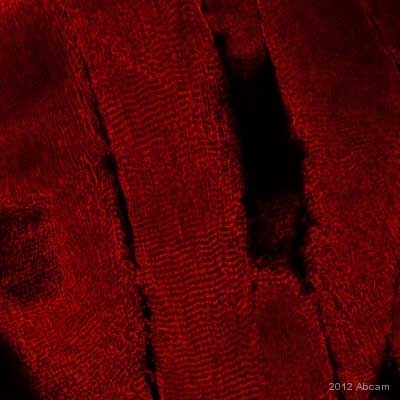
ab2819 staining SERCA1 ATPase in murine leg muscle by Immunohistochemistry (Frozen sections).Tissue was fixed in acetone, permeabilized using Triton X-100, blocked with 5% BSA for 1 hour at 22°C and then incubated with ab2819 at a 1/250 dilution for 1 hour at 22°C. The secondary used was a texas red conjugated donkey anti-mouse polyclonal used at a 1/500 dilution.See Abreview
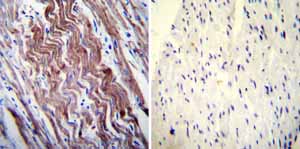
Immunohistochemistry was performed on both normal and cancer biopsies of deparaffinized Human heart tissue tissues. To expose target proteins heat induced antigen retrieval was performed using 10mM sodium citrate (pH6.0) buffer microwaved for 8-15 minutes. Following antigen retrieval tissues were blocked in 3% BSA-PBS for 30 minutes at room temperature. Tissues were then probed at a dilution of 1:200 with a mouse monoclonal antibody recognizing SERCA1 ATPase ab2819 or without primary antibody (negative control) overnight at 4°C in a humidified chamber. Tissues were washed extensively with PBST and endogenous peroxidase activity was quenched with a peroxidase suppressor. Detection was performed using a biotin-conjugated secondary antibody and SA-HRP followed by colorimetric detection using DAB. Tissues were counterstained with hematoxylin and prepped for mounting.
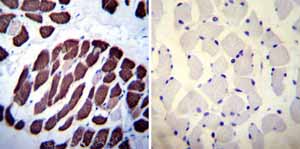
Immunohistochemistry was performed on both normal and cancer biopsies of deparaffinized Human skeletal muscle tissues. To expose target proteins heat induced antigen retrieval was performed using 10mM sodium citrate (pH6.0) buffer microwaved for 8-15 minutes. Following antigen retrieval tissues were blocked in 3% BSA-PBS for 30 minutes at room temperature. Tissues were then probed at a dilution of 1:100 with a mouse monoclonal antibody recognizing SERCA1 ATPase ab2819 or without primary antibody (negative control) overnight at 4°C in a humidified chamber. Tissues were washed extensively with PBST and endogenous peroxidase activity was quenched with a peroxidase suppressor. Detection was performed using a biotin-conjugated secondary antibody and SA-HRP followed by colorimetric detection using DAB. Tissues were counterstained with hematoxylin and prepped for mounting.



![Anti-SERCA1 ATPase antibody [VE121G9] (ab2819) at 1/500 dilution + Skeletal Muscle (Mouse) Tissue Lysate at 10 µgSecondaryGoat Anti-Mouse IgG H&L (HRP) preadsorbed (ab97040) at 1/5000 dilutiondeveloped using the ECL techniquePerformed under reducing conditions.](http://www.bioprodhub.com/system/product_images/ab_products/2/sub_4/28459_SERCA1-ATPase-Primary-antibodies-ab2819-9.jpg)
![Anti-SERCA1 ATPase antibody [VE121G9] (ab2819) at 1/1000 dilution (in PBS tweeb 0.05% for 1 hour at 22°C) + Whole tissue lysate of human neck muscle. at 20 µgSecondaryAn HRP-conjugated sheep anti-mouse polyclonal at 1/4000 dilutiondeveloped using the ECL technique](http://www.bioprodhub.com/system/product_images/ab_products/2/sub_4/28460_SERCA1-ATPase-Primary-antibodies-ab2819-12.jpg)


